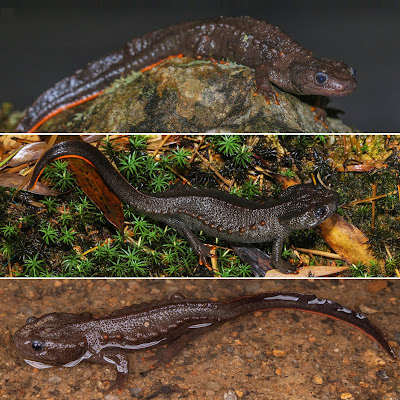 |
| Tylototriton sini Lyu, Wang, Zeng, Zhou, Qi, Wan & Wang, in Lyu, Wang, Zeng, ... et Wang, 2021 |
Abstract
In this work, a new species of the genus Tylototriton is described from Guangdong, southern China. Tylototriton sini sp. nov. was recorded as T. asperrimus for decades, and was indicated to represent an independent lineage based on recent molecular phylogenetic analyses. After detailed molecular analysis and morphological comparisons, Tylototriton sini sp. nov. is recognized as a distinct species which can be clearly distinguished from all known congeners by a combination of morphological characteristics and the significant divergence in the mitochondrial gene. Because the genus Tylototriton is of high conservation concern and all formally described members are protected by law, we also provide first data on the conservation status and recommendations for IUCN categorization for Tylototriton sini sp. nov. A suggestion on the species groups division of the genus Tylototriton is also provided based on their morphological differences and phylogenetic relationships.
Key words: Chresonymy, conservation, morphology, phylogeny, Tylototriton sini sp. nov., Yunkai Mountains
 |
| Figure 5. Tylototriton sini sp. nov. in life. A male paratype SYS a004679 B male paratype SYS a008353 in situ C an uncaptured individual in situ. |
Tylototriton sini Lyu, Wang, Zeng, Zhou, Qi, Wan & Wang, sp. nov.
Diagnosis: (1) Dorsolateral bony ridges on head low; (2) quadrate spines absent; (3) medium body size, TOL 118.4–124.5 mm in males, 144.5 mm in a single female; (3) snout obtusely rounded in dorsal view and rounded in lateral profile; (4) head longer than wide, HW/HL ratio 0.87–0.95; (5) supratemporal bony ridges and the sagittal ridge on head distinctly visible; (6) limbs slender, tips of forelimb and hindlimb overlapping when adpressed along the body; (7) vertebral ridge distinct, relatively smooth, not segmented; (8) rib nodules 12–13, relatively small, distinctly isolated from each other; (9) ground coloration dark brown; (10) digits orange with irregular dark brown mottling; (11) in breeding season, rib nodules mottled with orange coloration, much brighter in the first two rib nodules; (12) in breeding season, lateral tail dark brown, fin with dorsal orange margin, ventral tail ridge orange.
Etymology: The specific name sini refers to the outstanding biologist Prof. Shu-Szi Sin (= Shu-Zhi Xin, 辛树帜, 1894–1977). During his position at Sun Yat-sen University (1927–1931), Prof. Shu-Szi Sin organized repeated biology surveys throughout Guangxi, Guangdong, Guizhou, Hunan, and Hainan in southern China, pochally promoting the developments of zoological and botanic studies in this region. He collected specimens of T. asperrimus for the first time, as well as other amphibians and reptiles such as Quasipaa shini (Ahl, 1930) and the famous Shinisaurus crocodilurus Ahl, 1930. His family name “Sin” was mispronounced as “Shin” by the German researchers (Beolens et al. 2011), and we decided to use the correct spelling for this new species as Tylototriton sini sp. nov. in honor of Prof. Sin and his contributions.
Common name: Sin’s Knobby Newt (in English)
xīn shì yóu yuán (辛氏疣螈 in Chinese).
Distribution: Tylototriton sini sp. nov. is currently known only from its type locality Mt Yunkai and the neighboring Mt Ehuangzhang (this study; Hernandez 2018), both situated in the Yunkai Mountains of western Guangdong.
Natural history: This newt is terrestrial and inhabits leaf litters in well-preserved montane evergreen broad-leaf forest. During its breeding season from April to July, adult individuals can be observed in small ponds with muddy bottoms, small marshes, and vernal pools. Larvae can be found from June to August. On 15 August 2017, different stages of larvae were observed in the same vernal pool near the road (ca 2 m long and ca 3 m wide of the pool with water depth ca 4 cm), without adults observed (Fig. 6).
Zhi-Tong Lyu, Jian Wang, Zhao-Chi Zeng, Jia-Jun Zhou, Shuo Qi, Han Wan, You-Yu Li and Ying-Yong Wang. 2021. A New Species of the Genus Tylototriton (Caudata, Salamandridae) from Guangdong, southern China, with Discussion on the Subgenera and Species Groups within the Genus. Vertebrate Zoology. 71: 697-710. DOI: 10.3897/vz.71.e73563

